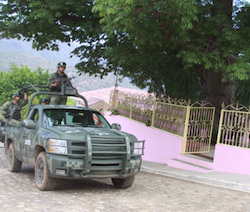Recent clashes between armed groups on the home turf of captured Sinaloa Cartel kingpin Joaquin “El Chapo” Guzmán illustrate how the fragmentation of Mexico’s underworld is changing the dynamics of criminal violence in the country.
Details of the confrontations have proven difficult to confirm, but both local and national media outlets have reported that hundreds of residents of the city of Badiraguato, Sinaloa — a long-time stronghold of El Chapo — have fled their homes in recent weeks due to ongoing violence in the area.
The current wave of bloodshed appears to have begun on June 11, with an incursion by a group of armed men in the Badiraguato-area municipality of La Tuna, where El Chapo’s mother resides. According to press reports, the gunmen — reportedly affiliated with the Sinaloa Cartel’s rival, the Beltran Leyva Organization (BLO) — ransacked the home of El Chapo’s mother, killed several people and stole vehicles from nearby areas.
A military source told El Informador that a Sinaloa Cartel member was among several people killed in a more recent series of clashes in the state capital Culiacán and in Cosalá, a town roughly forty miles south of Badiraguato. El Informador identified the deceased man as the reputed Sinaloa Cartel boss in Cosalá, Juan Carlos Landeros, alias “El Güero 90.”
Authorities have not officially confirmed who was behind these incidents. However, the award-winning Mexican journalist Anabel Hernández recently wrote in Proceso that another legendary figure of Mexico’s underworld, Rafael Caro Quintero, has spent the time since his August 2013 release from prison building alliances with the BLO and other criminal groups with the goal of mounting a hostile takeover of Sinaloa territory.
Hernández cites a military commander named Alfonso Duarte Múgica as confirming that the June 11 attack in La Tuna was directed by Alfredo Beltrán Guzmán — El Chapo’s nephew and the son of imprisoned former BLO leader Alfredo Beltrán Leyva. Sinaloan weekly Río Doce similarly reported that “at least two” anonymous sources told the news outlet that the attackers belonged to the BLO.
InSight Crime Analysis
A number of media reports, including those from Hernández and Río Doce, have portrayed the recent violence in Sinaloa as a sign of a wider war between the Sinaloa Cartel and the BLO. However, it is more likely that the recent clashes are a byproduct of the continuing fragmentation of Mexico’s criminal landscape, a development sure to be hastened by El Chapo’s arrest in January 2016 and the subsequent approval of two Mexican judges to extradite him to the United States.
SEE ALSO: Mexico News and Profiles
Mexican criminal groups now function less as large, hierarchical organizations, and more as decentralized networks. Allegiances among criminal actors are constantly shifting, and violent confrontations are prone to occur as these actors struggle to control strategically-important areas like Badiraguato, which is located in the “Golden Triangle” area of northwestern Mexico that is known for producing large amounts of marijuana and opium.
The recent confrontations in Sinaloa probably do not foreshadow a large-scale conflict between the BLO and the Sinaloa Cartel similar to what unfolded after the two groups split with one another in 2008. Rather, these incidents reflect how the dynamics of criminal violence are evolving as a result of the ongoing fragmentation of the Mexican underworld.

